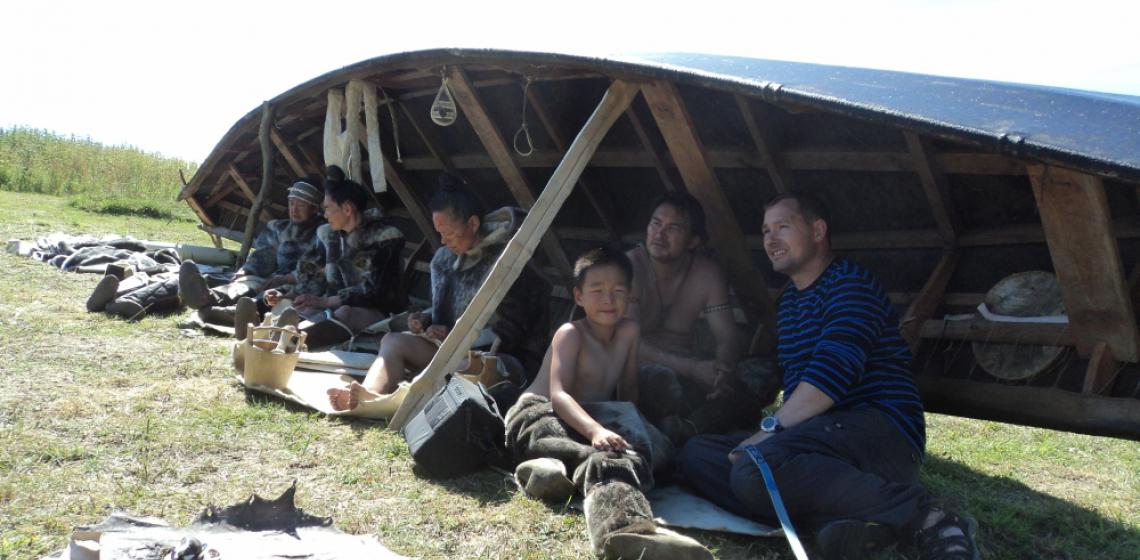
The Living Settlement (Nunaqarfik Uumassusilik or Levende Boplads) is a living project where visitors can experience the daily life of the last phase Thule Culture. The Project has a large potential in keeping the cultural heritage and interpreting and counts as well as a tourist attraction for the town.
The Living Settlement (Nunaqarfik Uumassusilik or Levende Boplads) is a living project where visitors can experience the daily life of the last phase Thule Culture. The Project has a large potential in keeping the cultural heritage and interpreting and counts as well as a tourist attraction for the town. The idea stems from the end of the 1990s. The project is all about building up a settlement from the start of the 17th century, the times just before Qasigiannguit was founded as a colony / village. The focus is on getting a better understanding of the daily life how it was back then, to reach a high degree of authenticity – although this will mean a long process of research and trying out. In winter, people get taught and equipment is produced; in summer it all comes to life in the open-air. The open-air activities are taking place outside the view of the village at the Taseruaq Bay. In summer you can visit the overnight settlement / Tammaarfik, as you would have been able to find back then: an overnight stay when the travellers would sleep under their Umiak. In the near future skin tents will be made at the site and the life of a summer settlement will be more complete.
The project was realized as a gift from the population to Qasigiannguit when the village celebrated its 275 year jubilee in the summer of 2009. The practical work started in 2008 with planning the technical parts of the site together with the preparation of the collection of materials for making tools, clothes, boats and house structures all up to the construction and manning of the first summer tent camp in the jubilee year 2009. In the following years, the project developed into cooperation between the population and a professional network throughout Qasigiannguit Katersugaasiviat. The first volunteer workgroups were set up in 2007. Meetings for the volunteers are nowadays about information and inspiration evenings with film, lectures about the 17th century, workshops and courses. The volunteers started in 2009 a group of friends “Aarnuat” which organises weekly evening meetings and plans monthly programs. The emphasis was on learning how to work skin, at first using modern tools which later got replaced.
Over the years, the Levende Boplads hopes to develop its offer as cultural heritage project for the whole Kommune and for both national and international guests. School children of all ages are included in the project. Teachers are working on including the project in the education year plans especially where it is about the local program. The support for the Project is growing as more people take part in the project one way or the other.
Artefacts
Toys and household are made following descriptions from ethnographic collections about the Disko Bay. Wooden objects were made from driftwood in the 17th century.
The clothes are made from traditionally worked skin and sewn with artificial sinew thread. Modern skin working and sewing tools were applied. The clothes of the guides of the project are sewn of tanned skin. The project wants to work in the future with skin which is not treated with modern soap and running water. The goal is to make costumes with only using 18th century techniques.
The women’s costumes are based on patters we have from the finds of Qilakitsoq which date to the end of the 14th century. Looking at paintings from the middle of the 16th century this way of dresses has remained unchanged for several centuries. That is why we chose these for our 1730 women’s dresses. The men’s costumes are modern and borrowed in the village – these haven’t undergone as much changes as the women’s clothing and that is why this solution was chosen in 2010. For children we used again the clothes from Qilakitsoq. We are unfamiliar with the 18th century girl’s costumes.
The goal of the project (in due time) is to build representations of 18th century seagoing vessels from the Disko Bay built of driftwood and with tools coming close to the tools which may have been used back then.
In 2010 the project used modern built boats. The Umiak is made in the 1980s in Qasigiannguit and is covered with sailcloth which is treated with line oil. Soon we will change the cover for seal skin. The kayak is based on a model of a 20th century seagoing west Greenland kayak. It is made in a course in kayak construction in 2009 and covered with nylon which got painted. The boat is built with modern tools.
